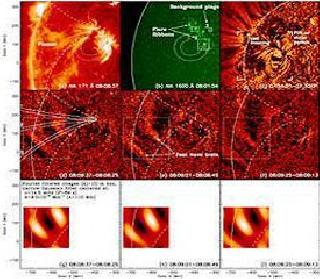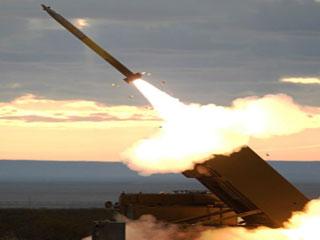
A image showing the funnel and loop in which fast waves propagate. Photo: NASA
PALO ALTO (BNS): NASA’s Solar Dynamics Observatory (SDO), have detected quasi-periodic waves in the low solar corona that travel at speeds as high as 2,000 kilometers per second (4.5 million miles per hour).
The scientists have found the waves using the Atmospheric Imaging Assembly (AIA) instrument.
For the first time, these observations have provided unambiguous evidence of propagating fast mode magnetosonic waves at such high speeds in the Sun’s low atmosphere.
Theories and computer models predicted the existence of slow and fast moving waves, and the former were clearly seen by solar observatories in space.
The waves are typically successive, arc-shaped fronts of intensity variations, similar to water ripples, which emanate near a flare kernel in the wake of a coronal mass ejection and propagate along a funnel of coronal loops.
The waves with the velocities of 1,000–2,000 kilometers per second in a period of 30–200 seconds range are believed to be responsible for many fundamental, yet enigmatic processes on the Sun, such as heating the corona to millions of degrees, accelerating the solar wind, triggering remote eruptions, and delivering energy and information between different parts of the atmosphere.
SDO is the first mission and flagship of NASA’s Living with a Star (LWS) programme launched near the onset of the new solar cycle on February 11, 2010. The goal of LWS is “to improve our understanding of how and why the Sun varies, how the Earth and Solar System respond, and how the variability and response affects humanity in Space and on Earth.”
SDO carries three state-of-the-art instruments: the AIA observing the tenuous solar corona permeated with magnetic fields, the Helioseismic Magnetic Imager (HMI) observing the surface Doppler velocity and magnetic field, and the Extreme UV Variability Experiment (EVE) recording the spatially integrated EUV spectrum of the Sun as a star.
“SDO is our ‘Hubble for the Sun’. It promises to transform solar physics in the same way the Hubble Space Telescope has transformed astronomy and cosmology,” Dr. Lika Guhathakurta, the LWS programme scientist, NASA headquarters said.
The solar telescope on NASA’s Transition Region and Coronal Explorer, the Focal Plane Package on the Japanese Hinode satellite, the Solar X-ray Imagers on GOES-N, -O and -P, the Extreme Ultraviolet Imager instruments on NASA’s twin STEREO spacecraft, and the Helioseismic and Magnetic Imager and the Atmospheric Imaging Assembly on NASA’s Solar Dynamics Observatory.
The ATC is currently building both the science instrument and spacecraft for NASA’s Interface Region Imaging Spectrograph (IRIS), a Small Explorer Mission scheduled for launch in late 2012.
 Previous Article
Previous Article Next Article
Next Article












The Indian Air Force, in its flight trials evaluation report submitted before the Defence Ministry l..
view articleAn insight into the Medium Multi-Role Combat Aircraft competition...
view articleSky enthusiasts can now spot the International Space Station (ISS) commanded by Indian-American astr..
view article